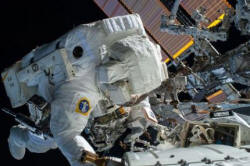|
 Astronauts
breeze through spacewalk to rig station for U.S. space taxis Astronauts
breeze through spacewalk to rig station for U.S. space taxis
 Send a link to a friend
Send a link to a friend
[March 02, 2015]
By Irene Klotz
CAPE CANAVERAL, Fla (Reuters) - Two U.S.
astronauts whipped through a third spacewalk outside the International
Space Station on Sunday to rig parking spots for new U.S. space taxis.
|
|
 Station commander Barry "Butch" Wilmore and flight engineer Terry
Virts expected to spend about seven hours installing antennas,
cables and navigation aides on the station's exterior truss.
Instead, the astronauts, who were making their third spacewalk in
eight days, were back inside the space station in 5.5 hours. Station commander Barry "Butch" Wilmore and flight engineer Terry
Virts expected to spend about seven hours installing antennas,
cables and navigation aides on the station's exterior truss.
Instead, the astronauts, who were making their third spacewalk in
eight days, were back inside the space station in 5.5 hours.
The purpose of the outings was to prepare berthing slips for
spaceships being developed by Boeing and Space Exploration
Technologies, or SpaceX.
Wilmore and Virts floated outside the Quest airlock shortly after 7
a.m. EST/1200 GMT, a NASA Television broadcast showed. Their job was
to install more than 400 feet (122 meters) of cables, a pair of
antennas and reflectors that the new spaceships will use to navigate
toward and dock with the station, a $100 billion laboratory that
flies about 260 miles (418 km) above Earth.
 After the spacewalk, Virts reported that a small amount of water had
seeped into his helmet, a situation that also occurred after a
spacewalk last week.
"It's no issue to crew safety," mission commentator Daniel Huot
said.
In July 2013, Italian astronaut Luca Parmitano nearly drowned when
water began leaking into his helmet. NASA immediately aborted the
spacewalk and suspended spacewalks while engineers figured out the
cause of the problem. The incident with the suit Virts was wearing
is unrelated, NASA said.
[to top of second column] |

Sunday's outing followed two spacewalks last week to rig power and
data cables for a pair of docking port adapters that are due to
arrive later this year. One adapter will be installed at the
berthing slip once used by NASA's space shuttles, which were retired
in 2011. The second docking system will be located at an adjacent
hatch on the Harmony connecting node.
Since the shuttles' retirement, the United States has been dependent
on Russia to fly crew to and from the station, a joint project of 15
nations.
NASA aims to break Russia's monopoly before the end of 2017 by
buying rides from Boeing and SpaceX.
(Editing by Clelia Oziel)
[© 2015 Thomson Reuters. All rights
reserved.]
Copyright 2015 Reuters. All rights reserved. This material may not be published,
broadcast, rewritten or redistributed.
 |